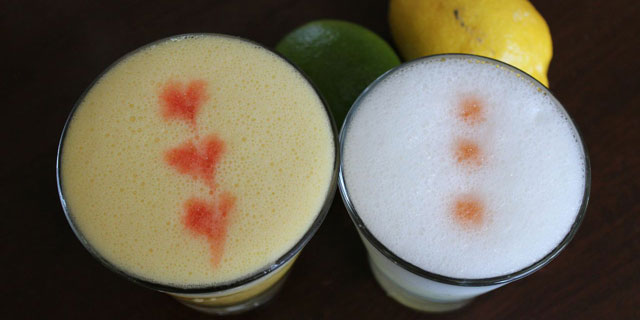The taste of that first pisco sour changed my summer in Chile and maybe my life. I was in the courtyard of Gaston Acurio's delightful Peruvian restaurant, LaMar, in Santiago, enjoying my first pisco sour cocktail and I was in love: a refreshing mix of citrus and pisco (a white grape brandy) topped with egg white foam.
The pisco sour has long been a beloved drink in the U.S.: a 1957 issue of Gourmet described pisco as an unaged brandy “imported in great earthenware pipkins by sailing ship from far-off Peru, where the volcanic soil gave to the grapes an essential genius encountered nowhere else on earth”; and my adopted hometown of San Francisco claims to have invented the pisco punch at the Bank Exchange Saloon in the mid 20th century.
Few other cocktails have set off such a debate over their history and origins. Let's rewind.
The Origin
History is sketchy on the birthplace of the pisco sour. Both Peru and Chile have claimed the cocktail as their own and both countries are officially recognized with a denomination of origin for pisco. In fact, in both Chile and Peru, the primary varietals used in its production are slightly different indigenous grapes. But because Peruvian food has been diffused abroad and because there seems to be some documentation placing pisco in Peru in the late 16th century, many believe Peru may be pisco's true home.
But Mauricio Banchieri Carter, trade commissioner of Chile in New York at Pro Chile and a native of Santiago, says that Chile has the right to use the term pisco in markets such as the United States and France. He concludes that, “it's totally silly, a dispute of origin when you only have two countries which produce Pisco and over 170 to sell it.”
While most Chileans don’t deny that pisco was first developed and manufactured in Peru, they argue that this name was used to designate the grape brandy produced in both countries. Many Chileans note that their claim to the distillate is based on the existence of two geographical wine-producing areas in Chile that are legally allowed to use the term pisco: Atacama and Coquimbo.
Where the cocktail was invented and how to make your own… [pagebreak]
The Lineage
The invention of the cocktail does not shed any more light on the topic. Victor Morris reportedly invented the pisco sour at his bar in Lima during the 1920’s. However Aom Aphiradee, the bar manager at LaMar in San Francisco says that, “documents such as printed advertisements or his bar’s register show that pisco sours were being served at the Morris Bar before anywhere else.”
He adds that recently saw a picture from a 1903 Peruvian cookbook that had two recipes for what would seem to be the pisco sours we know today.
Regardless of where it was invented or by whom, this cocktail remains a classic. The citrus and acidity is able to stand up to lime undertones of regional ceviches; it's cool and refreshing for the heat of long summer days; and it's subtly sweet with a beautiful yellow hue. Easy to look at and easy to drink.
It's also wonderfully easy to make in batches, so feel free to try it at your next party. According to Aphiradee, “It is my favorite drink to make for a party. I love that you can just put everything into a pitcher and you’re done.” Here's how to make your own with a Chilean or Peruvian pisco of your choosing, of course!
- 3 ounces pisco
- 1 ounce simple syrup
- 1 ounce key lime juice
- 0.75 ounce egg whites
- 2 to 3 drops of Angostura bitters


![Making Mealtime Matter with La Familia: Easy Sofrito [Video]](https://thelatinkitchen.com/wp-content/uploads/2015/10/sofrito-shutterstock__0-500x383.jpg)
![Easy Latin Smoothies: Goji Berry Smoothie [Video]](https://thelatinkitchen.com/wp-content/uploads/2015/12/goji_berry-shutterstock_-500x383.jpg)
















![Fun and Fast Recipes: Fiesta Cabbage Salad [Video]](https://thelatinkitchen.com/wp-content/uploads/2015/11/fiesta_cabbage_slaw-shutterstock_-500x383.jpg)









